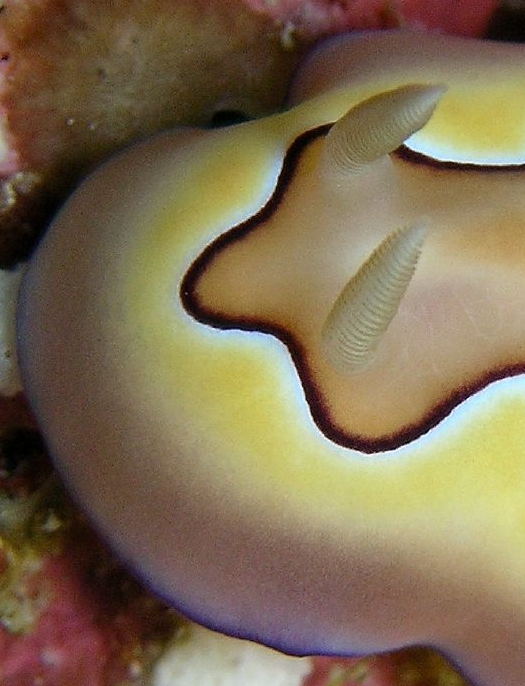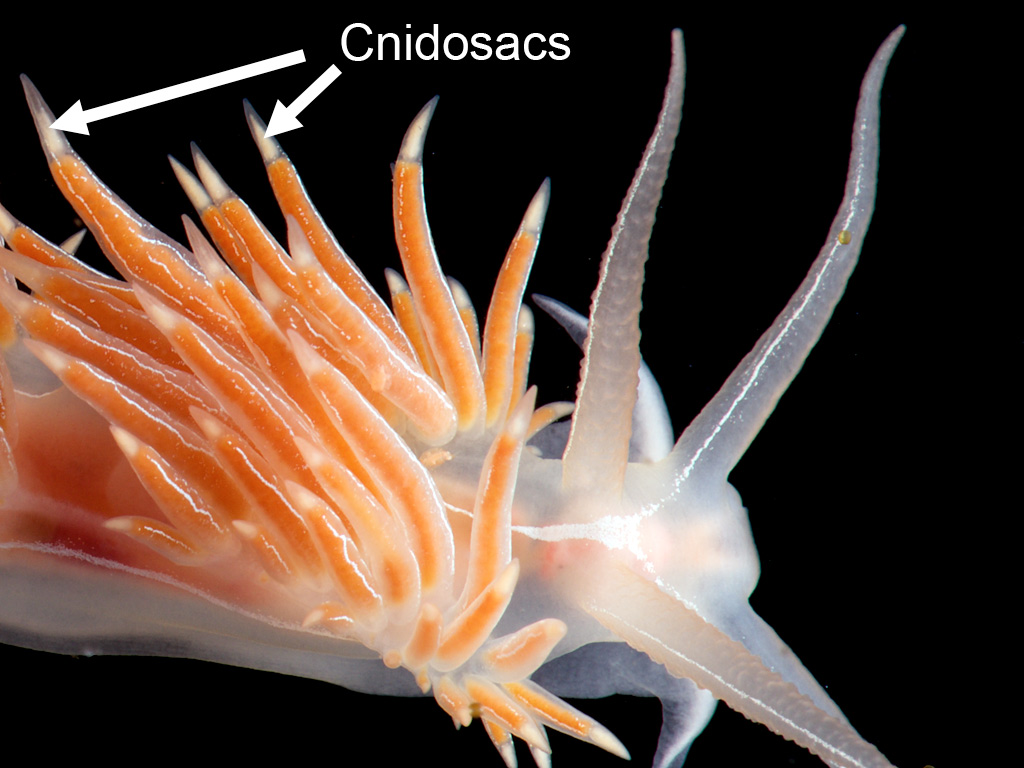|
Calmella Cavolini
''Calmella cavolini'' is a small aeolid (sea slug), with a maximum length of 12mm. It has smooth elongate rhinophores, oral tentacles, and angular anterior foot corners. Cerata, with a common stalk each, are arranged in groups. The front 3 ceratal clusters, which are on each side, are oppositely arranged but the posterior 3 ceratal clusters are arranged alternately. The color of digestive gland duct is bright red but the apical cnidosac is white in color. The jaw plates are purplish red and they show through each side of the slug's head as a reddish color spot. It was reported that it feeds on the hydroid, Eudendrium. Distribution ''C. cavolini'' is found in the Mediterranean Sea and the North Atlantic Ocean, near Europe; mainly Spain and Portugal Portugal, officially the Portuguese Republic ( pt, República Portuguesa, links=yes ), is a country whose mainland is located on the Iberian Peninsula of Southwestern Europe, and whose territory also includes the Atlanti ... [...More Info...] [...Related Items...] OR: [Wikipedia] [Google] [Baidu] |
Animal
Animals are multicellular, eukaryotic organisms in the Kingdom (biology), biological kingdom Animalia. With few exceptions, animals Heterotroph, consume organic material, Cellular respiration#Aerobic respiration, breathe oxygen, are Motility, able to move, can Sexual reproduction, reproduce sexually, and go through an ontogenetic stage in which their body consists of a hollow sphere of Cell (biology), cells, the blastula, during Embryogenesis, embryonic development. Over 1.5 million Extant taxon, living animal species have been Species description, described—of which around 1 million are Insecta, insects—but it has been estimated there are over 7 million animal species in total. Animals range in length from to . They have Ecology, complex interactions with each other and their environments, forming intricate food webs. The scientific study of animals is known as zoology. Most living animal species are in Bilateria, a clade whose members have a Symmetry in biology#Bilate ... [...More Info...] [...Related Items...] OR: [Wikipedia] [Google] [Baidu] |
Mollusca
Mollusca is the second-largest phylum of invertebrate animals after the Arthropoda, the members of which are known as molluscs or mollusks (). Around 85,000 extant species of molluscs are recognized. The number of fossil species is estimated between 60,000 and 100,000 additional species. The proportion of undescribed species is very high. Many taxa remain poorly studied. Molluscs are the largest marine phylum, comprising about 23% of all the named marine organisms. Numerous molluscs also live in freshwater and terrestrial habitats. They are highly diverse, not just in size and anatomical structure, but also in behaviour and habitat. The phylum is typically divided into 7 or 8 taxonomic classes, of which two are entirely extinct. Cephalopod molluscs, such as squid, cuttlefish, and octopuses, are among the most neurologically advanced of all invertebrates—and either the giant squid or the colossal squid is the largest known invertebrate species. The g ... [...More Info...] [...Related Items...] OR: [Wikipedia] [Google] [Baidu] |
Gastropoda
The gastropods (), commonly known as snails and slugs, belong to a large taxonomic class of invertebrates within the phylum Mollusca called Gastropoda (). This class comprises snails and slugs from saltwater, from freshwater, and from land. There are many thousands of species of sea snails and slugs, as well as freshwater snails, freshwater limpets, and land snails and slugs. The class Gastropoda contains a vast total of named species, second only to the insects in overall number. The fossil history of this class goes back to the Late Cambrian. , 721 families of gastropods are known, of which 245 are extinct and appear only in the fossil record, while 476 are currently extant with or without a fossil record. Gastropoda (previously known as univalves and sometimes spelled "Gasteropoda") are a major part of the phylum Mollusca, and are the most highly diversified class in the phylum, with 65,000 to 80,000 living snail and slug species. The anatomy, behavior, feeding, a ... [...More Info...] [...Related Items...] OR: [Wikipedia] [Google] [Baidu] |
Flabellinidae
Flabellinidae is a taxonomic family of brightly coloured sea slugs, specifically nudibranchs, marine gastropod mollusk Mollusca is the second-largest phylum of invertebrate animals after the Arthropoda, the members of which are known as molluscs or mollusks (). Around 85,000 extant species of molluscs are recognized. The number of fossil species is es ...s. This family has no subfamilies. Genera and species Genera within the family Flabellinidae include:Bouchet, P. (2011)Flabellinidae Bergh, 1889.In: MolluscaBase (2017). Accessed on 2018-01-13. * '' Calmella'' Eliot, 1910 * '' Carronella'' Korshunova, Martynov, Bakken, Evertsen, Fletcher, Mudianta, Saito, Lundin, Schrödl & Picton, 2017 * '' Coryphellina'' O'Donoghue, 1929 * '' Edmundsella'' Korshunova, Martynov, Bakken, Evertsen, Fletcher, Mudianta, Saito, Lundin, Schrödl & Picton, 2017 * '' Flabellina'' Gray, 1833 * '' Paraflabellina'' Korshunova, Martynov, Bakken, Evertsen, Fletcher, Mudianta, Saito, Lundin, S ... [...More Info...] [...Related Items...] OR: [Wikipedia] [Google] [Baidu] |
Calmella
''Calmella'' is a genus of sea slugs, aeolid nudibranchs, marine gastropod mollusks in the family Flabellinidae.Gofas, S.; Le Renard, J.; Bouchet, P. (2001). Mollusca. in: Costello, M.J. et al. (Ed.) (2001). ''European register of marine species: a check-list of the marine species in Europe and a bibliography of guides to their identification''. Collection Patrimoines Naturels. 50: pp. 180–213Bouchet, P.; Gofas, S. (2013)''Calmella'' Eliot, 1910.In: MolluscaBase (2017). Accessed through: World Register of Marine Species on 2018-010-13. Species There are three species within the genus ''Calmella'': * ''Calmella bandeli'' Ev. Marcus, 1976 * ''Calmella cavolini ''Calmella cavolini'' is a small aeolid (sea slug), with a maximum length of 12mm. It has smooth elongate rhinophores, oral tentacles, and angular anterior foot corners. Cerata, with a common stalk each, are arranged in groups. The front 3 ce ...'' (Vérany, 1846) * '' Calmella gaditana'' (Cervera, García-Gomez & G ... [...More Info...] [...Related Items...] OR: [Wikipedia] [Google] [Baidu] |
Aeolidida
The Aeolidida is a taxonomic clade of sea slugs, specifically aeolid nudibranchs, marine gastropod molluscs in the clade Cladobranchia. They are distinguished from other nudibranchs by their possession of cerata containing cnidosacs. Taxonomy *Superfamily Flabellinoidea (= Pleuroprocta) Bergh, 1889 **Family Apataidae Korshunova, Martynov, Bakken, Evertsen, Fletcher, Mudianta, Saito, Lundin, Schrödl & Picton, 2017 **Family Coryphellidae Bergh, 1889 **Family Cumanotidae Odhner, 1907 **Family Flabellinidae Bergh, 1889 **Family Flabellinopsidae Korshunova, Martynov, Bakken, Evertsen, Fletcher, Mudianta, Saito, Lundin, Schrödl & Picton, 2017 **Family Notaeolidiidae Eliot, 1910 **Family Paracoryphellidae M. C. Miller, 1971 **Family Samlidae Korshunova, Martynov, Bakken, Evertsen, Fletcher, Mudianta, Saito, Lundin, Schrödl & Picton, 2017 *Superfamily Fionoidea (= Acleioprocta) Gray, 1857Korshunova, T.; Martynov, A.; Picton, B. (2017)Ontogeny as an important part of int ... [...More Info...] [...Related Items...] OR: [Wikipedia] [Google] [Baidu] |
Rhinophores
A rhinophore is one of a pair of chemosensory club-shaped, rod-shaped or ear-like structures which are the most prominent part of the external head anatomy in sea slugs, marine gastropod opisthobranch mollusks such as the nudibranchs, sea hares (Aplysiomorpha), and sap-sucking sea slugs (Sacoglossa). Etymology The name relates to the rhinophore's function as an organ of "smell". ''Rhino-'' means nose from Ancient Greek ῥίς ''rhis'' and from its genitive ῥινός ''rhinos''. "Phore" means "to bear" from New Latin ''-phorus'' and from Greek -phoros (φορος) "bearing", a derivative of ''phérein'' (φέρειν). Function Rhinophores are scent or taste receptors, also known as chemosensory organs situated on the dorsal surface of the head. They are primarily used for distance chemoreception and rheoreception (response to water current). The "scents" detected by rhinophores are chemicals dissolved in the sea water. The fine structure and hairs of the rhinophore ... [...More Info...] [...Related Items...] OR: [Wikipedia] [Google] [Baidu] |
Cerata
:''The tortrix moth genus ''Cerata'' is considered a junior synonym of ''Cydia. Cerata, singular ceras, are anatomical structures found externally in nudibranch sea slugs, especially in aeolid nudibranchs, marine opisthobranch gastropod mollusks in the clade Aeolidida. The word ceras comes from the Greek word "κέρας", meaning "horn", a reference to the shape of these structures. Cerata are dorsal and lateral outgrowths on the upper surfaces of the body of these nudibranchs. Function Cerata greatly extend the surface area of nudibranchs and aid in respiration, the process of gas exchange for metabolic use. Cerata are also used, in some cases, for attack and defense. In many aeolid nudibranchs, the digestive system extends into the cerata. These nudibranchs eat stinging celled animals (Cnidarians) such as anemones, hydroids and sea fans or Portuguese men o' war. The stinging cells or nematocyst A cnidocyte (also known as a cnidoblast or nematocyte) is an explosi ... [...More Info...] [...Related Items...] OR: [Wikipedia] [Google] [Baidu] |
Hydroid (zoology)
Hydroids are a life stage for most animals of the class Hydrozoa, small predators related to jellyfish. Some hydroids such as the freshwater ''Hydra'' are solitary, with the polyp attached directly to the substrate. When these produce buds, they become detached and grow on as new individuals. The majority of hydroids are colonial. The original polyp is anchored to a solid substrate and forms a bud which remains attached to its parent. This in turn buds and in this way a stem is formed. The arrangement of polyps and the branching of the stem is characteristic of the species. Some species have the polyps budding directly off the stolon which roots the colony. The polyps are connected by epidermis which surrounds a gastrovascular cavity. The epidermis secretes a chitinous skeleton which supports the stem and in some hydroids, the skeleton extends into a cup shape surrounding the polyp. Most of the polyps are gastrozooids or feeding polyps, but some are specialised reproducti ... [...More Info...] [...Related Items...] OR: [Wikipedia] [Google] [Baidu] |
Eudendrium
''Eudendrium'' is a large genus of hydroids (Hydrozoa), one of two in the family Eudendriidae. These animals are marine cnidarias in the family Eudendriidae. Species Species so far described in this genus include: Retrieved August 3, 2012 * '' Eudendrium album'' Nutting, 1898 * '' Eudendrium angustum'' Warren, 1908 * '' Eudendrium annulatum'' Norman, 1864 * '' [...More Info...] [...Related Items...] OR: [Wikipedia] [Google] [Baidu] |
Mediterranean Sea
The Mediterranean Sea is a sea connected to the Atlantic Ocean, surrounded by the Mediterranean Basin and almost completely enclosed by land: on the north by Western and Southern Europe and Anatolia, on the south by North Africa, and on the east by the Levant. The Sea has played a central role in the history of Western civilization. Geological evidence indicates that around 5.9 million years ago, the Mediterranean was cut off from the Atlantic and was partly or completely desiccated over a period of some 600,000 years during the Messinian salinity crisis before being refilled by the Zanclean flood about 5.3 million years ago. The Mediterranean Sea covers an area of about , representing 0.7% of the global ocean surface, but its connection to the Atlantic via the Strait of Gibraltar—the narrow strait that connects the Atlantic Ocean to the Mediterranean Sea and separates the Iberian Peninsula in Europe from Morocco in Africa—is only wide. The Mediterranean ... [...More Info...] [...Related Items...] OR: [Wikipedia] [Google] [Baidu] |
North Atlantic Ocean
The Atlantic Ocean is the second-largest of the world's five oceans, with an area of about . It covers approximately 20% of Earth's surface and about 29% of its water surface area. It is known to separate the " Old World" of Africa, Europe and Asia from the "New World" of the Americas in the European perception of the World. The Atlantic Ocean occupies an elongated, S-shaped basin extending longitudinally between Europe and Africa to the east, and North and South America to the west. As one component of the interconnected World Ocean, it is connected in the north to the Arctic Ocean, to the Pacific Ocean in the southwest, the Indian Ocean in the southeast, and the Southern Ocean in the south (other definitions describe the Atlantic as extending southward to Antarctica). The Atlantic Ocean is divided in two parts, by the Equatorial Counter Current, with the North(ern) Atlantic Ocean and the South(ern) Atlantic Ocean split at about 8°N. Scientific explorations of the At ... [...More Info...] [...Related Items...] OR: [Wikipedia] [Google] [Baidu] |







